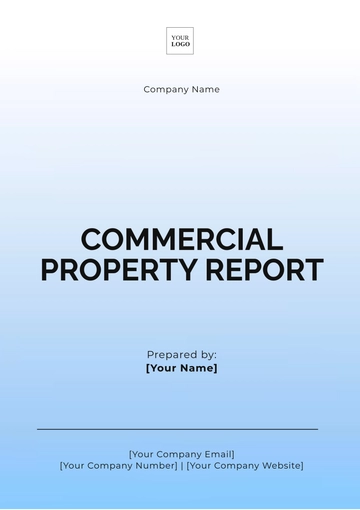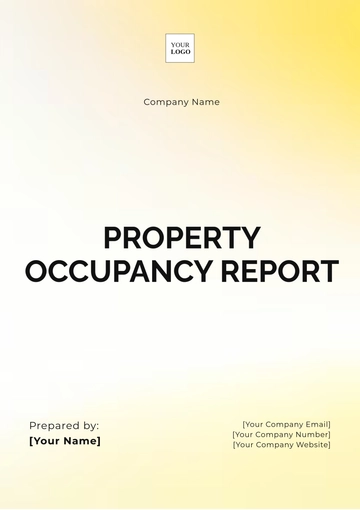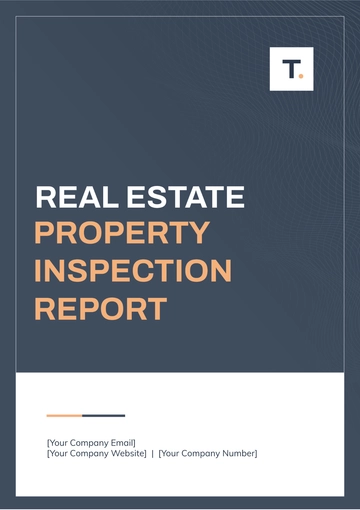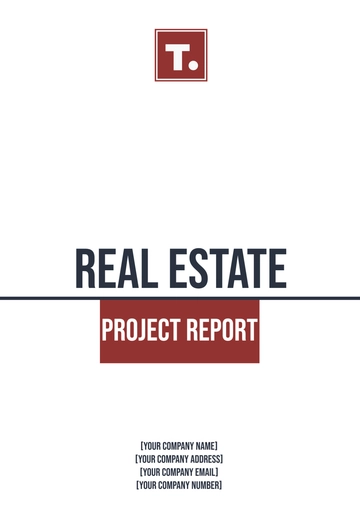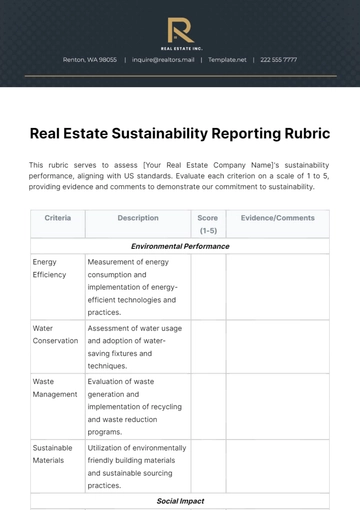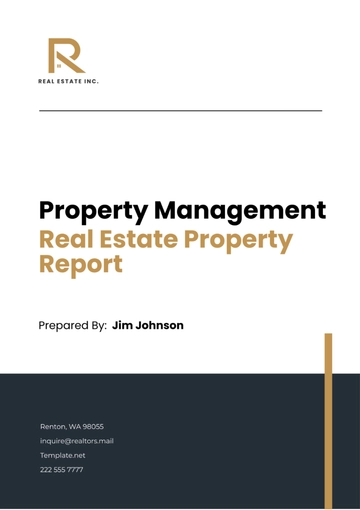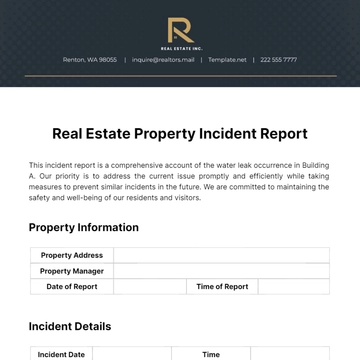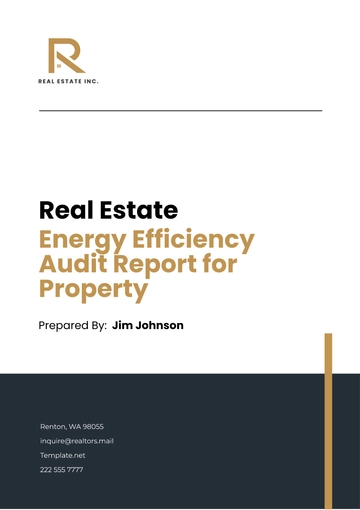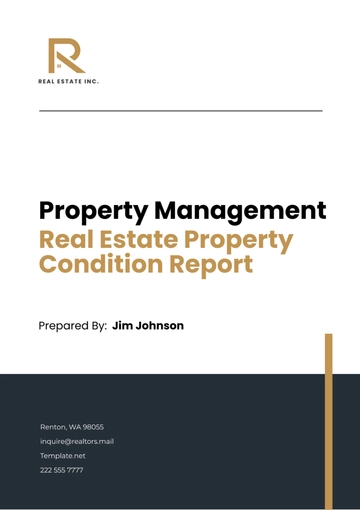Free Real Estate Property Report
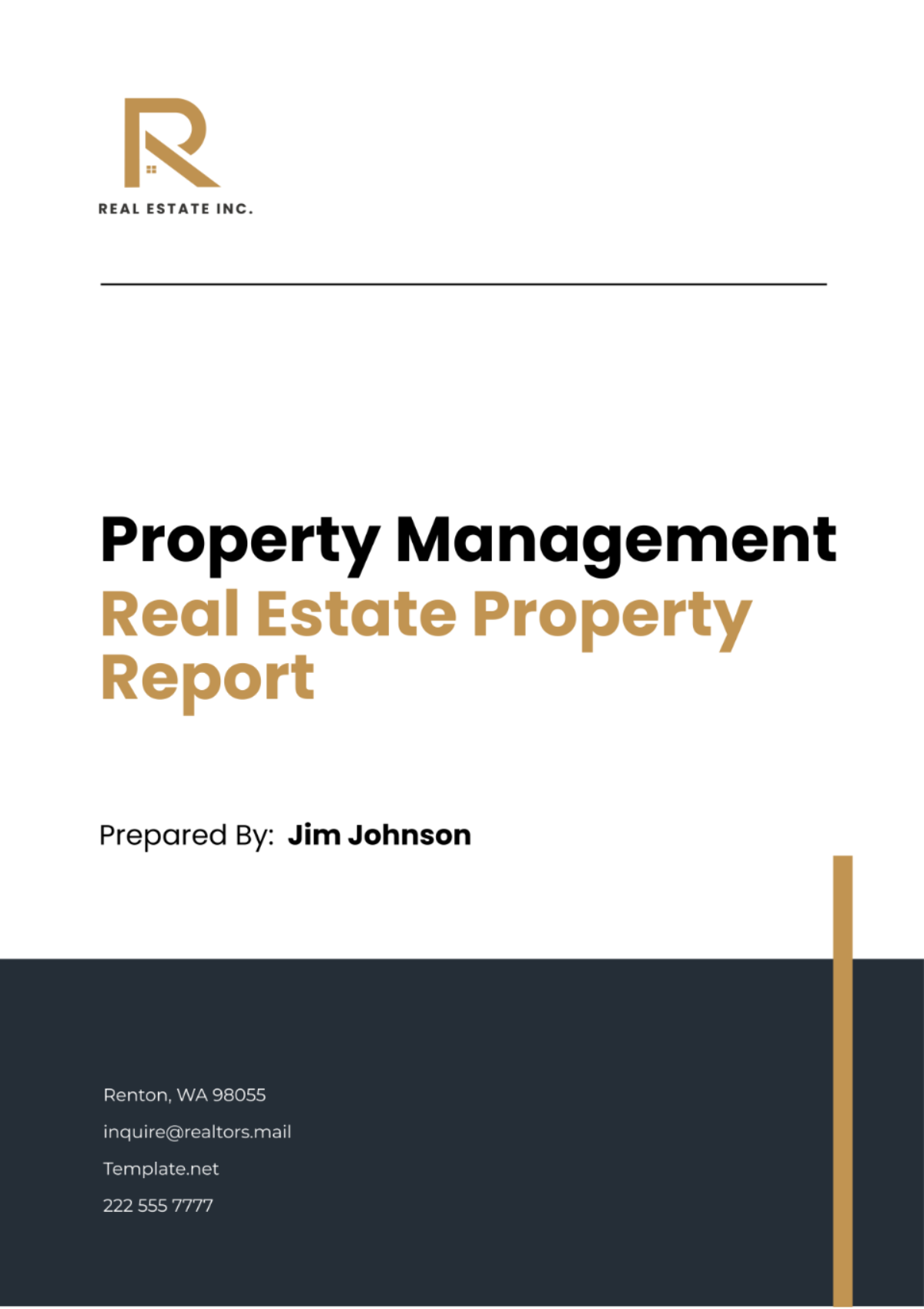
A. Executive Summary
The Real Estate Property Report, meticulously prepared for [YOUR COMPANY NAME], provides an in-depth analysis and comprehensive overview of the company’s current real estate holdings. Through detailed documentation, analytical review, and thoughtful interpretation of data, this report aims to shed light on prevailing market trends, uncover potential investment avenues, and highlight development opportunities that could significantly influence strategic business decisions.
Curated with precision by [YOUR NAME], this report delves into various aspects of the property portfolio, encompassing key parameters such as location, value, occupancy, and type. This holistic approach ensures a nuanced understanding of the portfolio's composition and its alignment with broader market dynamics, enabling [YOUR COMPANY NAME] to make informed, strategic moves in the real estate market.
B. Property Overview
The Property Overview provides a snapshot of the diverse and dynamic nature of [YOUR COMPANY NAME]'s real estate portfolio. Below is an introductory table that summarizes key information about each property, presenting a clear picture of the portfolio's composition:
Property ID | Location | Property Value | Property Status | Property Type |
|---|---|---|---|---|
101 | Downtown District | $1,200,000 | Occupied | Commercial |
102 | Eastern Hills | $800,000 | Vacant | Residential |
103 | Northern Suburb | $1,500,000 | Occupied | Industrial |
104 | Western Meadows | $700,000 | Vacant | Residential |
105 | South City | $1,000,000 | Occupied | Commercial |
This table serves as a foundation for understanding the strategic distribution and financial valuation of properties within the portfolio, highlighting the company’s presence across various regions and sectors.
C. Property Analysis
Comprehensive Analysis
Upon a thorough examination of the portfolio, it is evident that [YOUR COMPANY NAME] manages a robust and diversified collection of real estate assets. The blend of occupied and vacant properties illustrates a balanced approach to income generation and growth potential. With an aggregate property value of approximately $5.2 million, the portfolio stands as a testament to the company’s solid footing and capacity for steady asset growth within the real estate sector.
1. Market Trends
The real estate market is continually evolving, and our analysis has identified several key trends impacting the portfolio:
Urban Commercial Growth: There is a noticeable shift toward commercial properties in urban centers, driven by increasing business activities and the allure of high foot traffic, presenting lucrative opportunities for [YOUR COMPANY NAME] to capitalize on.
Industrial Expansion: The demand for industrial spaces near city outskirts is on the rise, spurred by the growth of manufacturing, logistics, and e-commerce sectors. This trend offers a promising avenue for portfolio diversification and investment.
Residential Market Dynamics: The residential sector exhibits stagnant growth, necessitating a strategic review of vacant properties and potential for conversion or redevelopment to better align with market demand.
Investment Resilience: Real estate continues to affirm its status as a steadfast investment channel, characterized by the potential for long-term appreciation and stability amidst economic fluctuations.
Value Appreciation: Across the board, property values are experiencing a steady uptrend, reinforcing the intrinsic value and future potential of [YOUR COMPANY NAME]'s real estate assets.
2. Investment Opportunities
In light of the aforementioned market trends, several strategic investment opportunities have been identified to enhance the portfolio’s performance and value:
Rental Transformations: Converting vacant residential properties into rental units could tap into ongoing demand and generate consistent income streams.
Commercial Acquisitions: Expanding the commercial property footprint in thriving urban and business districts aligns with market movements and could elevate the portfolio’s profitability.
Technology Integration: Investing in cutting-edge real estate technology for property management can streamline operations, enhance tenant experiences, and offer a competitive edge.
Property Upgrades: Upgrading existing properties can not only increase their market value but also attract higher-quality tenants and better rental rates.
Market Exploration: Venturing into new geographical markets or real estate sectors could uncover untapped potential and diversify investment risks.
By aligning strategic initiatives with these market trends and investment opportunities, [YOUR COMPANY NAME] is well-positioned to bolster its financial standing and continue its trajectory of growth within the ever-evolving landscape of the real estate industry.
D. Conclusion and Recommendations
[YOUR COMPANY NAME] possesses a formidable and diverse real estate portfolio, which, through strategic analysis and alignment with prevailing market trends, exhibits significant growth potential within the dynamic real estate sector. The insights gleaned from this comprehensive report underscore the company's capacity to enhance its financial stature and capitalize on emerging opportunities in a competitive landscape.
Given the current analysis, several key recommendations emerge to bolster [YOUR COMPANY NAME]'s position and ensure sustained growth and profitability:
Strategic Investment in High-Growth Areas: Prioritize acquisitions in urban commercial and industrial properties, areas identified as high-growth sectors. These investments are likely to yield higher returns, driven by increasing demand in urban centers and industrial zones.
Technological Advancements: Embrace and integrate cutting-edge technologies in property management to streamline operations, improve tenant relations, and enhance overall efficiency. Technologies such as AI-driven analytics, IoT for building management, and digital platforms for tenant engagement can significantly reduce operational costs and improve service delivery.
Optimization of Vacant Properties: Actively reevaluate and repurpose vacant residential properties. Considering the market's stagnant growth in residential sectors, transforming these properties into rental units or exploring commercial conversion where feasible could unlock additional revenue streams.
Enhancement and Upgradation: Invest in the modernization and upgrading of existing properties to elevate their market value and attractiveness to high-quality tenants. Focus on sustainability and energy efficiency improvements, which can also lead to cost savings and appeal to a growing segment of eco-conscious tenants.
Market Diversification: Explore expansion into new geographical markets or niches within the real estate sector that show promise for growth or resilience against market volatility. Diversification can reduce risks and open new avenues for investment and development.
Financial Prudence and Risk Management: While expansion and investment are recommended, maintaining a careful approach to financial management and risk assessment is crucial. Regularly review financial performance, monitor market trends for timely responses, and maintain adequate reserves to manage unforeseen challenges.
Stakeholder Engagement: Continue to engage with stakeholders, including investors, tenants, and community members, to gather insights and feedback. This engagement can enhance decision-making, tenant satisfaction, and corporate reputation, contributing to long-term success.
By adopting these recommendations, [YOUR COMPANY NAME] is not only poised to amplify its financial achievements but also to reinforce its standing as a forward-thinking leader in the real estate industry. This proactive and strategic approach will enable the company to navigate the complexities of the market, seize upon lucrative opportunities, and achieve sustainable growth in the years to come.
- 100% Customizable, free editor
- Access 1 Million+ Templates, photo’s & graphics
- Download or share as a template
- Click and replace photos, graphics, text, backgrounds
- Resize, crop, AI write & more
- Access advanced editor
Discover the Real Estate Property Report Template from Template.net! Effortlessly create comprehensive property reports with this versatile template. Edit and customize it to fit your specific requirements using our intuitive AI editor tool. Whether you're analyzing market trends or evaluating property performance, this template has you covered. Streamline your reporting process today with Template.net!
You may also like
- Sales Report
- Daily Report
- Project Report
- Business Report
- Weekly Report
- Incident Report
- Annual Report
- Report Layout
- Report Design
- Progress Report
- Marketing Report
- Company Report
- Monthly Report
- Audit Report
- Status Report
- School Report
- Reports Hr
- Management Report
- Project Status Report
- Handover Report
- Health And Safety Report
- Restaurant Report
- Construction Report
- Research Report
- Evaluation Report
- Investigation Report
- Employee Report
- Advertising Report
- Weekly Status Report
- Project Management Report
- Finance Report
- Service Report
- Technical Report
- Meeting Report
- Quarterly Report
- Inspection Report
- Medical Report
- Test Report
- Summary Report
- Inventory Report
- Valuation Report
- Operations Report
- Payroll Report
- Training Report
- Job Report
- Case Report
- Performance Report
- Board Report
- Internal Audit Report
- Student Report
- Monthly Management Report
- Small Business Report
- Accident Report
- Call Center Report
- Activity Report
- IT and Software Report
- Internship Report
- Visit Report
- Product Report
- Book Report
- Property Report
- Recruitment Report
- University Report
- Event Report
- SEO Report
- Conference Report
- Narrative Report
- Nursing Home Report
- Preschool Report
- Call Report
- Customer Report
- Employee Incident Report
- Accomplishment Report
- Social Media Report
- Work From Home Report
- Security Report
- Damage Report
- Quality Report
- Internal Report
- Nurse Report
- Real Estate Report
- Hotel Report
- Equipment Report
- Credit Report
- Field Report
- Non Profit Report
- Maintenance Report
- News Report
- Survey Report
- Executive Report
- Law Firm Report
- Advertising Agency Report
- Interior Design Report
- Travel Agency Report
- Stock Report
- Salon Report
- Bug Report
- Workplace Report
- Action Report
- Investor Report
- Cleaning Services Report
- Consulting Report
- Freelancer Report
- Site Visit Report
- Trip Report
- Classroom Observation Report
- Vehicle Report
- Final Report
- Software Report

